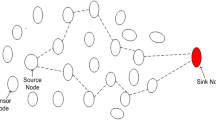Abstract
Routing optimization is a promising platform in wireless sensor network (WSN) for many researchers to work on various problems related to the balancing of performance parameters required by an application. In a sensor network, multipath routing protocol design is influenced by many factors, which includes hardware constraints, scalability, operating environment, reliability, topology, fault tolerance, transmission media, and power consumption which are addressed by many researchers. Balancing of these factors plays vital role in designing a routing protocol because they are application specific and vary from one application to another. All these performance metrics which are considered as application requirement must be measurable, independent and comparable. This paper focuses on designing a framework that balances the various performance metrics to get near optimal solution for multipath routing in WSNs. This framework is a hybrid approach that combines the dynamic programming model of DNA sequence algorithm with the existing Multipath routing algorithms to get the optimized routing sequence to balance the real time traffic and non-real time traffic on the multiple paths with improved energy and throughput parameters. Simulation results confirms the significant improvement in throughput performance and packet delivery ratio, substantial reduction in energy consumption against standard Multipath routing protocols.





Similar content being viewed by others
References
Akyildiz, I. F., Su, W., Sankarasubramaniam, Y., & Cayirci, E. (2002). A survey on sensor networks. IEEE Communications Magazine, 40, 102–114.
Radi, M., Dezfouli, B., Bakar, K. A., & Lee, M. (2012). Multipath routing in wireless sensor networks: Survey and research challenges. Sensors, 12, 650–685. https://doi.org/10.3390/s120100650.
Tsai, J., & Moors, T. (2006). A review of multipath routing protocols: From wireless ad hoc to mesh networks. In The proceedings of ACoRN early career researcher workshop on wireless multihop networking, Sydney, Australia, July 17–18, 2006.
Yang, Y. (2013). Routing protocols for wireless sensor networks: A survey. Dissertation.
Iqbal, M., Naeem, M., Anpalagan, A., Ahmed, A., & Azam, M. (2015). Review wireless sensor network optimization: Multi-objective paradigm. Sensors, 15, 17572–17620. https://doi.org/10.3390/s150717572.
Fei, Z., Li, B., Yang, S., & Hanzo, L. (2016). A survey of multi-objective optimization in wireless sensor networks: Metrics, algorithms and open problems. IEEE Communications Surveys and Tutorials, 19, 550–586.
Womersley, R. (2008). Local and global optimization.
Rahmani, E., Fakhraie, S. M., & Kamarei, M. (2006). Finding agent-based energy-efficient routing in sensor networks using parallel genetic algorithm. In Proceedings of the 2006 international conference on microelectronics, Dhahran, Saudi Arabia (pp. 119–122).
EkbataniFard, G. H., Monsefi, R., Akbarzadeh-T, M.-R., & Yaghmaee, M. H. (2010). A multi-objective genetic algorithm based approach for energy efficient QoS-routing in two-tiered wireless sensor networks. In Proceedings of the 5th IEEE international symposium on wireless pervasive computing, Modena, Italy, 5–7 May 2010 (pp. 80–85).
Gupta, S. K., Kuila, P., & Jana, P. K. (2013). GAR: An energy efficient ga-based routing for wireless sensor networks. In C. Hota & P. K. Srimani (Eds.), Distributed computing and internet technology (pp. 267–277). Heidelberg: Springer.
Kumar, J. S., & Raj, E. B. (2012). Genetic algorithm based multicast routing in wireless sensor networks—A research framework. IJEIT, 2, 240–246.
Camilo, T., Carreto, C., Jorge, S. S., & Boavida, F. (2006). An energy-efficient ant-based routing algorithm for wireless sensor networks. In M. Dorigo L. M. Gambardella, M. Birattari, A. Martinoli, R. Poli, & T. Stützle (Eds.), Ant colony optimization and swarm intelligence. ANTS 2006. Lecture notes in computer science (Vol. 4150). Berlin: Springer.
Yang, J., Xu, M., Zhao, W., & Xu, B. (2010). A multipath routing protocol based on clustering and ant colony optimization for wireless sensor networks. Sensors, 10, 4521–4540.
Song, X., Wang, C., & Pei, J. (2012). 2ASenNet: A multiple QoS metrics hierarchical routing protocol based on swarm intelligence optimization for WSN. In Proceedings of the 2012 IEEE international conference on information science and technology, Hubei, China (pp. 531–534), 23–25 March 2012.
Sim, K., & Sun, W. (2003). Ant colony optimization for routing and load-balancing: Survey and new directions. IEEE Transactions on Systems, Man, and Cybernetics Part A: Systems and Humans, 33(5), 560–572.
Cardoso, P., Jesus, M., & Marquez, A. (2003). Monaco-multi-objective network optimization based on an aco. In Proceedings of the X Encuentros de Geometrıa computational, Seville, Spain.
Pinto, D., Baran, B., & Fabregat, R. (2005). Multi-objective multicast routing based on ant colony optimization. In Proceeding of the 2005 conference on artificial intelligence research and development (pp. 363–370).
Kulkarni, R. V., Forster, A., & Venayagamoorthy, G. K. (2011). Computational intelligence in wireless sensor networks: A survey. IEEE Communications Surveys and Tutorials, 13(1), 68–96.
Adnan, Md. A, Razzaque, M. A., Ahmed, I., & Isnin, I. F. (2014). Bio-mimic optimization strategies in wireless sensor networks: A survey. Sensors, 14, 299–345. https://doi.org/10.3390/s140100299.
Needleman, S. B., & Wunsch, C. D. (1970). A general method applicable to search for similarities in the amino acid sequence of two proteins. Journal of Molecular Biology, 48, 443–453.
Heinzelman, W. R., Chandrakasan, A., & Balakrishnan, H. (2000). Energy-efficient communication protocol for wireless micro sensor networks. In Proceedings of the 33rd annual Hawaii international conference on system sciences (HICSS-33’00) (p. 223), Hawaii, USA.
http://www.maths-in industry.org/miis/285/1/4_National_Institute_of_Genomic_Medicine.pdf
Author information
Authors and Affiliations
Corresponding author
Additional information
Publisher's Note
Springer Nature remains neutral with regard to jurisdictional claims in published maps and institutional affiliations.
Rights and permissions
About this article
Cite this article
Jayanthi, N., Valluvan, K.R. Bio-inspired Optimization Routing Technique Using DNA Sequencing Algorithm for Wireless Sensor Networks. Wireless Pers Commun 101, 2365–2381 (2018). https://doi.org/10.1007/s11277-018-5821-3
Published:
Issue Date:
DOI: https://doi.org/10.1007/s11277-018-5821-3




